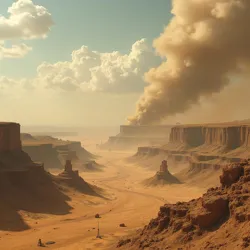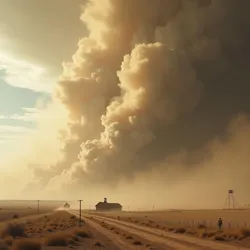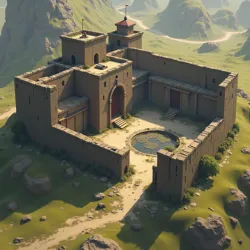post desiccation united states

Vast arid landscape showing fractured remnants of civilization, dust storms, and struggle for survival.
Great Desiccation
['Arid', 'Toxic']
Fragmented Continent
['Fragmented', 'Localized']
Water Scarcity
Barter
Crumbling Infrastructure
| Region | Primary Environmental Condition(s) | Dominant Social Structure(s) | Key Challenges | Notable Examples/Features |
|---|---|---|---|---|
| Cascade Mountains | Relatively less arid, protected valleys | Enclaves, Kinship groups | Isolation, Limited Resources | Telurian Enclaves, Telurian people |
| Great Basin | Salt flats, Dust dunes, Extreme Temps | Nomadic Tribes, Scavengers | Water Scarcity, Environmental Hazards, Raiding | Difficult Passage Routes, Hidden Springs |
| Great Plains | Dust Bowl, High Winds, Scarce Water | Nomadic Tribes, Small Fortified Settlements | Dust Storms, Water Scarcity, Mutated Megafauna | Dustwind Nomads |
| Urban Ruins | Crumbling Infrastructure, Toxins | Gangs, Isolated Pockets | Structural Collapse, Contamination, Violence | Ruins of Denver, Salt Lake City, Boise |
| Coastal Regions | Rising Sea Levels, Altered Currents | Maritime Communities | Storms, Contamination, Coastal Raiders | Saltwater Exchange, Coastal Scavenging |
| Former Industrial Areas | High Toxicity, Radiation Hotspots | Highly Isolated Groups, Few Survivors | Extreme Contamination, Long-term Health Risks | Exclusion Zones, Dangerous Scavenging Grounds |
The landscape known in the late 21st century as the United States of America underwent a radical and devastating transformation following the period referred to as the Great Desiccation. This era, commencing in the aftermath of widespread ecological collapse and societal breakdown, is characterized by extreme environmental degradation, the fragmentation of centralized authority, and the struggle for survival among scattered human communities. The term "Post-Desiccation United States" refers to this altered geopolitical and environmental reality, a fractured continent where the remnants of the old world lie buried beneath dust and ruin, and new, often precarious, ways of life have emerged. This period is notably traversed by figures like the Telurian shaman Maerion and his Draakar bodyguard Korthos during their Humoral Hike, providing firsthand accounts of the conditions and challenges faced by inhabitants.
The environmental changes wrought by the Great Desiccation were profound and long-lasting. Driven by a complex interplay of climatic shifts, resource depletion, and infrastructure failure, the continent experienced widespread desertification, the collapse of major river systems, and the proliferation of toxic environments. The once-familiar geography was reshaped, with vast areas becoming virtually uninhabitable wastelands. This environmental catastrophe was not merely a backdrop to human struggle but a fundamental force shaping every aspect of existence, from the availability of basic resources like water and food to the emergence of new diseases and the necessity for radical adaptation.
Societal structures fractured and collapsed under the immense pressure of environmental stress and resource scarcity. The federal government and most state authorities ceased to function effectively, leading to a power vacuum filled by localized strongmen, tribal leaders, and various organized factions. The dense urban populations of the pre-Desiccation era were decimated by famine, disease, and conflict, with survivors dispersing into smaller, more manageable groups or attempting to eke out an existence in the ruins of cities. This fragmentation resulted in a mosaic of independent settlements, nomadic groups, and fortified enclaves, each with its own rules, customs, and struggles for survival. The Humoral Hike highlights the diversity of these communities, from relatively stable groups in the Telurian Enclaves to desperate scavengers in urban ruins and resilient nomadic tribes in the dust bowls.
Environmental Landscape
The defining feature of the Post-Desiccation United States is its radically altered environment. The prolonged megadrought that was central to the Great Desiccation transformed vast areas into arid or semi-arid zones, fundamentally altering ecosystems and rendering much of the land unsuitable for traditional agriculture or habitation. This environmental shift created novel and dangerous conditions that survivors had to navigate daily.
 Massive dust storm towering over a desolate, dry landscape with scarce vegetation and remnants of old structures.
Massive dust storm towering over a desolate, dry landscape with scarce vegetation and remnants of old structures.The former heartlands of American agriculture, particularly in the Midwest and Great Plains, became expansive dust bowls. Decades of drought, combined with the loss of vegetative cover and unsustainable farming practices that stripped away topsoil, resulted in relentless wind erosion. Massive dust storms, sometimes hundreds of miles wide and thousands of feet high, became a regular occurrence, carrying fine particulate matter across vast distances. These storms were not merely inconvenient; they could bury settlements, destroy crops, cause severe respiratory illnesses, and reduce visibility to near zero, making travel perilous. The composition of the dust often included not only parched earth but also toxic residues from industrial sites and agricultural chemicals, further contaminating the environment.
Water scarcity is perhaps the most critical challenge across the Post-Desiccation landscape. Major river systems like the Mississippi, Missouri, and Colorado have significantly reduced flow, with many tributaries drying up entirely. The extensive network of lakes and reservoirs that once provided reliable water sources have shrunk dramatically or vanished. Surviving communities are often clustered around remaining water sources, such as deep wells, natural springs, or areas where atmospheric condensation can be reliably harvested. Control over these limited water supplies is a frequent source of conflict, driving territorial disputes between settlements and nomadic groups. The search for potable water is a constant, arduous task, often requiring hazardous journeys into unexplored or dangerous territories.
Toxic Zones and Mutated Ecosystems
Beyond the widespread aridity, large areas of the Post-Desiccation United States are marked by severe contamination from industrial waste, failed infrastructure, and accidental releases. Abandoned factories, power plants, and waste disposal sites have become sources of leaked chemicals and heavy metals, poisoning the soil and remaining water sources. The degradation of nuclear facilities and storage sites, particularly in regions like the Southwest and parts of the former industrial East, has created radiation hotspots, rendering these areas uninhabitable for centuries. Exposure to these toxins contributes to a range of severe health issues among the surviving population, including the wasting sickness known as Aegrotism.
The environmental pressures have also driven rapid and unpredictable Ecological Mutations. Plant life in affected areas often displays distorted growth patterns, altered chemical compositions, and in some cases, defensive or predatory adaptations. Animals have also undergone significant changes, leading to the emergence of Mutated megafauna – creatures that have grown to immense size, developed enhanced senses, or possess new, dangerous abilities due to exposure to toxins, radiation, or rapid environmental selection pressures. These mutated creatures pose significant threats to human survival, acting as apex predators in the ruined ecosystems and making travel and resource gathering extremely dangerous. Accounts from the Humoral Hike frequently detail encounters with such creatures, underscoring the pervasive danger of the environment.
Regional Variations
While the Desiccation's effects were widespread, their intensity varied across the continent. The western mountain ranges, such as the Cascades where the Telurian Enclaves are located, often retained more moisture due to elevation and specific microclimates, making them relatively more habitable, though still facing challenges. The former coastal regions, particularly those with deep harbors, saw the emergence of maritime-focused communities adapted to scavenging coastal ruins and utilizing the less affected ocean resources, although rising sea levels and altered ocean currents also presented new challenges.
The vast interior, however, bore the brunt of the environmental collapse. The Great Basin became a desolate expanse of salt flats and dust dunes, while the Great Plains were transformed into the aforementioned dust bowls. The Mississippi River valley, once a fertile breadbasket, became a complex and dangerous mosaic of shrinking waterways, toxic swamps, and heavily contested pockets of arable land. The former Northeast corridor, with its dense population and heavy industrialization, became a landscape of crumbling urban ruins interspersed with toxic zones and fragmented, often warring, survivor communities.
The stark differences in environmental conditions across the continent mean that survival strategies and the nature of human communities vary significantly from region to region. What works in the relatively sheltered valleys of the Cascades is impossible in the open dust plains, and life in the ruins of a former city presents unique challenges compared to life along a shrinking river. This environmental heterogeneity contributes to the deep fragmentation of society and the difficulty of large-scale organization or communication.
Societal Structure and Survival
The collapse of centralized authority and the environmental devastation led to a radical restructuring of human society in the Post-Desiccation United States. The complex systems of governance, economy, and social organization that defined the pre-Desiccation era dissolved, replaced by a patchwork of localized power structures and survival-focused communities.
 A small, defended community built from salvaged materials, clustered around a vital resource like water, with walls and lookouts.
A small, defended community built from salvaged materials, clustered around a vital resource like water, with walls and lookouts.The most common unit of social organization is the small, self-sufficient settlement or enclave. These communities are typically centered around a defensible location with access to a relatively reliable resource, most often water. They range in size from a few dozen individuals to several hundred and are characterized by strong internal cohesion, born out of shared necessity and mutual defense. Governance within these settlements varies widely, from councils of elders (as seen in the Telurian Enclaves) to charismatic leaders, hereditary rulers, or even democratic assemblies. The primary focus of these communities is immediate survival: securing food, water, shelter, and defense against external threats.
Nomadic groups are also a significant feature of the landscape, particularly in the more desolate regions. These groups, such as the Dustwind Nomads, have adapted to moving across the ravaged land, following scarce resources, trading with settled communities, and scavenging the ruins. They often possess deep knowledge of the land, including hidden water sources and safe travel routes, and have developed unique survival skills suited to their mobile lifestyle. While some nomadic groups are peaceful traders, others are opportunistic raiders, preying on vulnerable settlements and travelers.
Warlords and Factions
In the power vacuum left by the collapse of the federal government, various factions and warlords rose to prominence, controlling territories through force. These groups range from organized bands of raiders who survive by looting and extortion to more structured military-style organizations that control key resources or strategic locations. Warlords often rule through intimidation and violence, their authority based on their ability to command loyal fighters and protect their territory or assets. Conflict between these factions is endemic, further destabilizing the landscape and making travel and trade dangerous. The journey of Maerion and Korthos frequently involves navigating the territories controlled by such groups, sometimes seeking safe passage, other times defending themselves against attack.
Religious and ideological movements have also emerged, providing frameworks for meaning and social cohesion in a chaotic world. Groups like the Ironclad Pilgrims, encountered during the Humoral Hike, demonstrate how belief systems can shape identity, purpose, and even survival strategies in the post-Desiccation era. These movements often incorporate elements of pre-Desiccation history, environmental themes, or unique spiritual interpretations of the cataclysm and its aftermath. Some are benevolent, focused on mutual aid and rebuilding, while others are militant and exclusionary.
The economy of the Post-Desiccation United States is largely based on Barter and localized trade. Pre-Desiccation currency is worthless, replaced by direct exchange of goods and services. Water, food, fuel (often scavenged or produced locally), medical supplies, and functional technology are the most valuable commodities. Trade networks exist, connecting disparate settlements and allowing for the exchange of goods that cannot be produced locally. These networks are often fragile and vulnerable to disruption by raiders, environmental hazards, or conflict between factions. Major trading hubs, like the nascent Saltwater Exchange that has emerged on the Pacific coast, become vital centers for regional commerce and interaction, though they are often contested and require significant defense.
Challenges of Daily Life
Daily life for most inhabitants of the Post-Desiccation United States is a constant struggle for survival. Securing adequate food and water is paramount. Agriculture is difficult due to arid conditions, depleted soil, and mutated pests, requiring innovative techniques and drought-resistant crops. Hunting and gathering are dangerous due to mutated fauna and contaminated environments. Scavenging the ruins of the old world is a common, but risky, activity, yielding valuable resources but also exposing individuals to structural collapse, environmental toxins, and hidden dangers.
Disease is rampant, exacerbated by malnutrition, unsanitary conditions, and environmental contaminants. Conditions like Aegrotism are a constant threat, and even common ailments can be deadly without access to effective medicine. The lack of widespread medical infrastructure means that traditional healing practices, such as those employed by Maerion using Visceral Harmony and Telurian herbs like Moonpetal, Sunstone Root, and Shadowmoss, become incredibly valuable and sought after.
Security is a perpetual concern. The threat of raiders, bandits, and hostile factions is ever-present, requiring communities to maintain defenses and individuals to be constantly vigilant. Travel between settlements is hazardous, making isolation a common reality for many. The need for defense often leads to the development of local militias and the construction of fortifications, turning many settlements into small, defensible strongholds. Korthos's role as Maerion's Draakar bodyguard highlights the necessity of protection in this dangerous world.
Remnants of the Old World
The landscape of the Post-Desiccation United States is littered with the physical remnants of the pre-Desiccation era. Cities, towns, highways, and infrastructure lie in varying states of ruin, serving as a constant reminder of the world that was lost. These ruins are not merely historical artifacts; they are integrated into the fabric of post-Desiccation life, serving as sources of shelter, building materials, and valuable scavenged technology.
 Dilapidated skyscrapers and buildings in a former city, overgrown with mutated plants and showing signs of collapse and scavenging.
Dilapidated skyscrapers and buildings in a former city, overgrown with mutated plants and showing signs of collapse and scavenging.Former urban centers like Boise, Salt Lake City, and Denver, mentioned in accounts of the Humoral Hike, are now vast, dangerous zones of crumbling skyscrapers, collapsed bridges, and debris-filled streets. Within these ruins, pockets of survivors may exist, often utilizing the remaining structures for shelter and defense, or adapting underground spaces like subway tunnels for habitation. However, the urban ruins are also prime territory for raiders, mutated creatures, and hidden environmental hazards like gas leaks or unstable structures. Navigating these areas requires extreme caution and local knowledge.
The extensive highway system of the pre-Desiccation United States, once a symbol of connectivity, is now largely broken and impassable. Sections may be buried under dust, collapsed from earthquakes or environmental stress, or blocked by debris. What remains of the road network is often used by nomadic groups or those undertaking long-distance journeys like the Humoral Hike, but travel is slow, dangerous, and requires bypassing numerous obstacles. The skeletal remains of vehicles litter the roadsides, rusting monuments to a bygone era of easy transportation.
Technology and Scavenging
Pre-Desiccation technology is a double-edged sword in this new world. Functional technology is incredibly valuable, providing access to capabilities that are otherwise unavailable. Generators, water purification systems, medical equipment, and communication devices (if they can be made to work) are highly sought after. Groups like the Ironclad Pilgrims specialize in the retrieval and repurposing of such technology, often viewing it with a mix of reverence and practicality.
However, much of the remaining technology is broken, useless, or dangerous. Old power grids are defunct, communication networks are silent, and complex machinery is beyond the repair capabilities of most survivors. Furthermore, some pre-Desiccation sites, particularly those related to heavy industry or military operations, are highly contaminated or contain dangerous substances that pose a threat to scavengers. The knowledge of how to safely interact with, repair, or repurpose old technology is a valuable skill, often passed down through generations or held by specialized groups.
The material culture of the Post-Desiccation United States is heavily influenced by scavenging. Buildings are constructed from salvaged materials, tools are fashioned from scrap metal, and clothing is often patched together from remnants. This reliance on scavenging creates a unique aesthetic, characterized by practicality, improvisation, and the visible layers of history. The artifacts of the old world are integrated into the new, repurposed for survival and reflecting the harsh realities of the present.
Cultural and Human Adaptation
In the face of immense hardship and the loss of their former world, the inhabitants of the Post-Desiccation United States have demonstrated remarkable resilience and adaptability. New cultures, traditions, and belief systems have emerged, shaped by the environment and the shared experience of survival.
Survival is not solely a matter of physical endurance; it also requires psychological and social adaptation. Communities have developed strong bonds of mutual aid and cooperation, essential for facing external threats and overcoming environmental challenges. Storytelling, music, and art, often drawing on the experiences of the Desiccation and the struggles of survival, play a crucial role in maintaining social cohesion, transmitting knowledge, and preserving a sense of identity. The stories of figures like Maerion and Korthos, and their Humoral Hike, are examples of how narratives emerge to make sense of the world and offer hope.
Traditional knowledge and skills, particularly those related to living in harmony with the natural world, have become increasingly valuable. The Telurian people's deep understanding of herbalism, ecology, and sustainable practices, exemplified by Maerion's Visceral Harmony, is a prime example. As conventional medicine and technology became scarce, reliance on natural remedies and traditional healing methods increased. Similarly, skills like tracking, hunting, foraging, and understanding weather patterns, once perhaps seen as archaic, are now essential for survival.
The experience of the Desiccation has also led to shifts in values and priorities. The pursuit of material wealth and consumerism, central to the pre-Desiccation economy, has been replaced by a focus on basic needs, community well-being, and environmental stewardship (in communities that have learned from the past). Respect for resources, especially water, is paramount. A deep distrust of centralized authority and large, complex systems is common, born from the experience of their collapse.
Arts and Oral Tradition
In a world with limited access to pre-Desiccation media and literacy, oral tradition has become a vital means of preserving history, transmitting knowledge, and entertaining. Stories of the "Old Times," the Desiccation itself, and the struggles and triumphs of survival are passed down through generations. Ballads, epic poems, and folk tales recount heroic deeds, cautionary environmental lessons, and the myths surrounding figures like the wandering healers.
Visual arts often utilize scavenged materials and reflect the harsh beauty of the post-Desiccation landscape. Murals on the walls of settlements depict scenes of survival, community life, and the dangers of the outside world. Sculptures are crafted from scrap metal and bone. Music often incorporates improvised instruments made from found objects, creating unique sounds that reflect the resilience and ingenuity of the people.
Consider this passage from a salvaged and partially preserved journal, attributed to a traveler encountered by Maerion and Korthos:
The dust blows ever east, a shroud over the bones of the cities. We found refuge in a hollowed-out bank vault, the thick metal doors a mockery of the wealth once held within. Now, our wealth is clean water, a handful of dried rations, and the warmth of a shared fire. The old world is a ghost that haunts our steps, its towers crumbling like sandcastles in the wind. But life persists. We sing old songs, though the words sometimes catch in our throats, and we watch the stars, the same stars that shone on a world we barely remember. Survival is not just breathing; it is remembering, and it is hoping, even when hope feels like a mirage in the dust.
This excerpt captures the blend of despair, resilience, and connection to the past that characterizes much of the human experience in the Post-Desiccation United States.
Future Prospects and Challenges
The future of the Post-Desiccation United States remains uncertain. The environmental conditions are still harsh, and the threat of further ecological shifts or the emergence of new environmental hazards is ever-present. The fragmented nature of society makes large-scale cooperation and rebuilding efforts difficult.
However, signs of potential recovery and the emergence of new forms of organization are visible. The existence of relatively stable communities, like the Telurian Enclaves, and the development of regional trade networks, such as the growing influence of the Saltwater Exchange, suggest the possibility of greater interconnectedness and stability in the future. The knowledge and practices of groups like the Telurian people, focused on sustainable living and environmental harmony, offer potential pathways for adapting to and even mitigating the effects of the Desiccation in the long term.
The journeys of figures like Maerion and Korthos, and the impact of their Humoral Hike, demonstrate the power of individual initiative and compassion in fostering hope and facilitating healing across the fragmented landscape. While their journey is a solitary one, the stories and aid they provide resonate widely, inspiring others and fostering connections between isolated communities.
Major challenges remain. The widespread environmental toxicity requires long-term solutions that are currently beyond the capabilities of most communities. The threat of violence from raiders and warlords hinders trade and cooperation. Diseases like Aegrotism continue to claim lives. Overcoming these obstacles will require not only resilience and adaptation but also the development of new forms of collective action and potentially the rediscovery or innovation of technologies capable of addressing the environmental damage.
The Post-Desiccation United States is a land of ruins and resilience, of danger and nascent hope. It is a testament to the devastating power of environmental collapse and the enduring capacity of humanity to survive and adapt in the face of overwhelming adversity. Its future is being forged in the scattered settlements, on the dusty plains, and within the crumbling ruins of the old world, shaped by the struggles, innovations, and shared journeys of its inhabitants.
The Post-Desiccation United States, therefore, is not a unified entity but a collection of disparate regions and communities, each facing unique challenges and developing distinct strategies for survival in a world fundamentally altered by the Great Desiccation. The journey of Maerion and Korthos provides a narrative thread that connects some of these disparate elements, highlighting the shared human experience of loss, struggle, and the enduring pursuit of healing and hope.